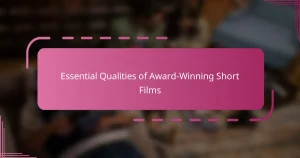The article focuses on the technical aspects of feature film submissions, detailing essential requirements for successful entry into film festivals and screenings. Key considerations include the submission format, commonly DCP or ProRes, with a recommended resolution of 1920×1080 pixels or higher for HD quality. Sound quality is emphasized, often necessitating 5.1 surround sound mixing, while aspect ratios such as 16:9 or 2.35:1 are critical for visual presentation. Proper encoding settings and comprehensive metadata, including title, director, and contact information, are also crucial for ensuring compatibility with screening equipment and optimizing the viewing experience.

What are the Technical Aspects to Consider in Feature Film Submissions?
Technical aspects to consider in feature film submissions include format, resolution, and sound quality. Submissions generally require specific formats like DCP or ProRes. The resolution should typically be 1920×1080 pixels or higher for HD quality. Sound must meet standards, often requiring 5.1 surround sound mixing. Aspect ratio is also crucial; common ratios include 16:9 or 2.35:1. Additionally, proper encoding settings must be followed to ensure compatibility with screening equipment. Metadata is essential for identification and should include title, director, and contact information. These technical requirements help ensure optimal viewing experiences and facilitate the submission process.
Why are technical aspects crucial for feature film submissions?
Technical aspects are crucial for feature film submissions because they ensure compatibility with industry standards. Proper resolution, aspect ratio, and audio quality are essential for screenings. Submissions that do not meet these specifications can be automatically disqualified. For instance, many festivals require films to be in 4K resolution. Additionally, audio must be mixed to specific decibel levels for optimal playback. Failure to adhere to these technical requirements can hinder a film’s chances of acceptance. Festivals often prioritize films that demonstrate professionalism and attention to detail. Overall, technical quality directly impacts the viewing experience and perception of the film.
What role do technical specifications play in film festivals?
Technical specifications are crucial for film festivals as they determine the eligibility and quality of submitted films. These specifications include aspects such as resolution, aspect ratio, sound format, and file type. Adhering to these technical requirements ensures that films can be properly screened and evaluated. Festivals often have strict guidelines to maintain a high standard of presentation. For example, a film submitted in an incompatible format may be disqualified from consideration. Additionally, technical specifications impact the audience’s viewing experience and the overall festival’s reputation. Thus, they play a vital role in the selection and presentation process.
How can technical quality impact audience perception?
Technical quality significantly influences audience perception. High technical quality enhances clarity and engagement in film. Clear visuals and crisp audio create a more immersive experience. Poor technical quality can distract viewers and undermine storytelling. Research shows that 85% of audiences associate high production values with better storytelling. This association affects their overall enjoyment and emotional response. Consequently, films with superior technical quality are more likely to receive positive reviews and attract larger audiences.
What specific technical requirements should filmmakers be aware of?
Filmmakers should be aware of several specific technical requirements for feature film submissions. These include adhering to resolution standards, typically 1920×1080 (HD) or 3840×2160 (4K). Filmmakers must also ensure proper aspect ratios, commonly 16:9 or 2.39:1. Audio specifications are critical; submissions should have a minimum of 48 kHz sample rate and 24-bit depth. File formats must meet industry standards, such as ProRes or DNxHD for video and WAV or AIFF for audio. Color grading should conform to Rec. 709 or Rec. 2020 standards. Additionally, filmmakers should include closed captions or subtitles for accessibility. These requirements are essential for compatibility with various distribution platforms and festival screenings.
What are the standard video formats required for submissions?
The standard video formats required for submissions typically include MP4, MOV, and AVI. These formats are widely accepted across various film festivals and platforms. MP4 is favored for its balance of quality and file size. MOV is preferred for its high-quality video and audio capabilities. AVI is also accepted but may result in larger file sizes. These formats ensure compatibility with most media players and editing software. Submitting in these formats helps avoid technical issues during screenings.
How important is audio quality in feature film submissions?
Audio quality is crucial in feature film submissions. High audio quality enhances the overall viewing experience. Poor audio can distract audiences and detract from storytelling. Many film festivals prioritize audio clarity in their selection criteria. Research indicates that sound significantly impacts audience engagement and perception. For instance, a study by the University of Southern California found that 70% of viewers consider sound quality essential for enjoyment. Therefore, filmmakers must ensure professional audio standards in their submissions.
What are common pitfalls in technical submissions?
Common pitfalls in technical submissions include lack of adherence to submission guidelines. Many submissions fail to meet specified formats or resolutions. Inconsistent audio levels can also detract from the overall quality. Poorly edited footage often results in a disjointed narrative. Additionally, neglecting to include necessary metadata can hinder the review process. Submitting incomplete files or missing documentation is another frequent error. Lastly, overlooking the importance of a clear, engaging synopsis can diminish interest in the project. Each of these pitfalls can significantly impact the chances of a successful submission.
What mistakes do filmmakers often make regarding file sizes?
Filmmakers often make mistakes related to file sizes by not optimizing their video files for submission. This can lead to excessively large file sizes that are difficult to upload or transfer. Many filmmakers fail to use appropriate codecs and compression settings, resulting in unnecessary bulk. This can also affect playback quality and compatibility with submission platforms. Additionally, some filmmakers overlook the required specifications of festivals or distributors. Ignoring these guidelines can lead to rejected submissions. Properly managing file sizes is crucial for efficient delivery and meeting technical requirements.
How can improper encoding affect submission acceptance?
Improper encoding can lead to submission rejection. Submissions often require specific formats and codecs. If the encoding does not meet these requirements, the file may not be playable. This can result in reviewers being unable to view the content. Consequently, the submission is likely to be dismissed. Technical standards for submissions are outlined by festivals and platforms. Failure to adhere to these standards can compromise the submission process. For example, a study by the International Federation of Film Producers Associations states that 30% of submissions are rejected due to technical issues, including encoding errors.
How can filmmakers ensure their submissions meet technical standards?
Filmmakers can ensure their submissions meet technical standards by adhering to specific guidelines provided by film festivals or distribution platforms. Each festival typically outlines technical specifications for video resolution, audio quality, and file format. For instance, many festivals require submissions in HD resolution, such as 1920×1080 pixels. Audio standards often specify a minimum bitrate, commonly 48 kHz for sound. Filmmakers should also verify that their submission files are in accepted formats, like MOV or MP4.
Additionally, filmmakers can use software tools to check their files against these requirements. Tools like MediaInfo provide detailed information about video and audio specifications. Conducting a final review of the film’s technical aspects before submission is crucial. This review helps identify any discrepancies that could lead to rejection. Following these steps increases the likelihood of a successful submission.
What tools and resources can help with technical preparation?
Software tools like Adobe Premiere Pro and Final Cut Pro assist in video editing. They provide advanced features for precise editing and color correction. Audio software such as Pro Tools enhances sound quality and mixing. These tools are industry standards, ensuring professional output.
Online resources like YouTube offer tutorials on editing techniques and software usage. Websites like No Film School provide articles and forums for filmmakers. These resources help users stay updated on industry trends and best practices.
Technical preparation also benefits from equipment rentals. Companies like LensRentals provide access to high-quality cameras and lenses. This allows filmmakers to test equipment before purchase.
Networking through platforms like LinkedIn connects filmmakers with industry professionals. This can lead to collaboration and mentorship opportunities. Such connections are valuable for learning and growth in technical skills.
What software is recommended for editing and formatting films?
Adobe Premiere Pro is recommended for editing and formatting films. It offers a comprehensive suite of tools for video editing. This software supports various file formats and resolutions. It is widely used in the film industry for its versatility. Final Cut Pro is another popular option, especially among Mac users. It provides powerful editing capabilities and a user-friendly interface. DaVinci Resolve is also noteworthy for its advanced color grading features. These software options are standard in professional film production.
How can filmmakers test their submissions before sending?
Filmmakers can test their submissions by conducting thorough pre-submission screenings. This involves gathering a test audience to evaluate the film’s content and pacing. Filmmakers should also check technical specifications like video format and audio quality. Running the film through various playback devices ensures compatibility. Additionally, filmmakers can seek feedback from industry professionals for constructive criticism. Reviewing submission guidelines from festivals or distributors is crucial to meet their requirements. Finally, filmmakers should perform a final quality check to catch any errors before submission.
What best practices should be followed for technical film submissions?
Best practices for technical film submissions include adhering to specific formatting guidelines. Filmmakers should ensure their films are in the correct file format, such as MP4 or MOV. Proper resolution is essential; 1080p is commonly accepted. Audio quality must be clear, typically at 48 kHz for film submissions. Subtitles should be included if required, formatted correctly for readability. Filmmakers should also check for any specific submission requirements from the festival or platform. Meeting deadlines for submissions is crucial to avoid disqualification. Lastly, filmmakers should maintain backups of their submissions to prevent loss.
How can filmmakers create a checklist for technical requirements?
Filmmakers can create a checklist for technical requirements by identifying key elements needed for production. Start by listing equipment such as cameras, lighting, and sound gear. Include specifications for each item, like resolution and frame rate for cameras. Next, outline software requirements for editing and visual effects. Document file formats needed for distribution and screening. Consider technical standards for sound mixing and color grading. Review industry guidelines for submission formats to festivals. Finally, ensure all team members have access to the checklist for consistency. This structured approach helps streamline the production process and meets industry standards.
What tips can enhance the overall quality of a submission?
To enhance the overall quality of a submission, focus on clarity and professionalism. Ensure that the submission is well-structured and free of errors. Use a consistent format throughout the document. Include a clear and concise logline that summarizes the project. Provide a detailed synopsis that captures the essence of the story. Highlight the unique selling points of the project to engage the reader. Utilize high-quality visuals or references where applicable to support the narrative. Submit the materials in the required file format and adhere to any specified guidelines. Following these tips can significantly improve the chances of a successful submission.
The main entity of this article is “Technical Aspects to Consider in Feature Film Submissions.” The article provides a detailed overview of essential technical requirements filmmakers must adhere to when submitting feature films to festivals. Key topics include format specifications, resolution standards, audio quality, and common pitfalls in submissions. It emphasizes the importance of meeting industry standards for a successful submission, including proper encoding, metadata inclusion, and adherence to guidelines. Additionally, it offers best practices and tools for filmmakers to enhance their submission quality and ensure compatibility with screening platforms.


